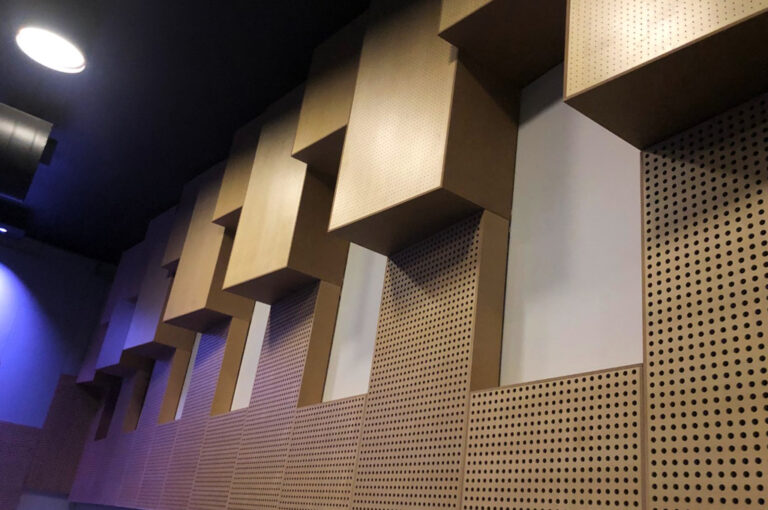In today’s world, noise pollution has become an ever-present concern in both residential and commercial spaces. Whether you’re in a bustling city or a busy office, managing sound effectively is essential for comfort, productivity, and overall well-being. When it comes to sound management, two popular solutions often emerge: acoustic wood panels and traditional soundproofing methods. This article explores the differences between these two approaches, helping you make an informed choice for your specific needs.
Understanding Acoustic Wood Panels
Acoustic wood panels are specially designed to absorb sound waves, thereby minimizing echo and reverberation within a space. These panels are typically made from high-quality wood and incorporate various design elements, such as grooves and perforations, that enhance their sound-absorbing capabilities. By strategically placing acoustic wood panels in a room, you can significantly improve the acoustic quality, making it ideal for environments like homes, studios, offices, and auditoriums.
Traditional Soundproofing Methods
Traditional soundproofing methods generally focus on creating a barrier to block sound from entering or leaving a space. Common materials used in traditional soundproofing include:
- Mass-loaded vinyl (MLV): A dense, flexible material that can be installed in walls, ceilings, and floors to block sound transmission.
- Insulation: Fiberglass or foam insulation is placed within walls and ceilings to absorb sound.
- Soundproof drywall: This is specially designed to reduce sound transmission between rooms.
- Double-glazed windows: These windows consist of two panes of glass separated by a layer of air, reducing noise from the outside.
While effective, traditional soundproofing methods can often be more invasive, requiring significant construction work and potentially altering the aesthetics of a space.
Key Differences Between Acoustic Wood Panels and Traditional Soundproofing
1. Functionality
The primary difference between acoustic wood panels and traditional soundproofing lies in their functionality. Acoustic wood panels are designed to absorb sound, improving the quality of sound within a space. They reduce echoes and enhance clarity, making them perfect for environments where audio quality is crucial, such as recording studios, home theaters, and conference rooms.
In contrast, traditional soundproofing aims to prevent sound from entering or leaving a space. While this method is effective for keeping external noise out or containing sound within a room, it does not address issues of sound clarity or echo.
2. Installation Process
Installing acoustic wood panels is generally straightforward and non-invasive. Panels can be mounted on walls and ceilings using adhesives or mechanical fasteners. This flexibility allows homeowners and business owners to enhance their acoustic environment without significant renovations.
On the other hand, traditional soundproofing often requires more extensive work, including drywall replacement, insulation installation, or window replacements. This can lead to higher labor costs and longer installation times.
3. Aesthetic Appeal
A significant advantage of acoustic wood panels is their aesthetic appeal. Available in various finishes and designs, they add warmth and elegance to any space. Homeowners and designers appreciate the natural look of wood, which can complement a range of interior styles, from rustic to modern.
Traditional soundproofing materials, while effective, often lack visual appeal. Options like soundproof drywall or mass-loaded vinyl can disrupt the aesthetics of a room, making it challenging to maintain a cohesive design.
4. Cost Considerations
When considering cost, acoustic wood panels typically offer a more budget-friendly solution, especially for those looking for an elegant way to manage sound. The price of acoustic panels can vary based on materials and design, but they often provide a significant return on investment in terms of improved sound quality and aesthetics.
Traditional soundproofing methods can be more expensive due to the materials and labor involved in installation. Costs can escalate quickly, especially if extensive renovations are required.
Which Solution is Right for You?
The decision between acoustic wood panels and traditional soundproofing depends on your specific needs:
- Choose Acoustic Wood Panels if:
- You want to improve sound quality in a space where clarity is essential (e.g., music rooms, theaters, or conference rooms).
- Aesthetic appeal is a priority, and you want to enhance the design of your interior.
- You prefer a straightforward installation process that requires minimal disruption.
- Choose Traditional Soundproofing if:
- Your primary concern is blocking external noise or containing sound within a room (e.g., for home studios, busy offices, or apartments).
- You’re willing to undertake extensive renovations and modifications to achieve your soundproofing goals.
- You need a solution for high noise transmission issues, such as those associated with urban environments or near highways.
Combining Both Approaches
For optimal results, many homeowners and businesses choose to combine both acoustic wood panels and traditional soundproofing methods. By implementing acoustic panels in conjunction with soundproofing materials, you can achieve a well-rounded sound management solution. For example, using acoustic wood panels in a room alongside insulated walls and double-glazed windows can significantly enhance both sound quality and privacy.
Read also: Get the Durable and Lightweight 180-ah lifepo4 battery
Conclusion
When it comes to managing sound in your home or office, understanding the differences between acoustic wood panels and traditional soundproofing is crucial. Acoustic wood panels offer an elegant, effective way to improve sound quality and aesthetics, while traditional soundproofing focuses on blocking noise. By considering your specific needs and the characteristics of each solution, you can make an informed choice that enhances your space’s comfort and functionality. Whether you opt for one approach or a combination of both, investing in sound management will undoubtedly lead to a more pleasant and productive environment.

